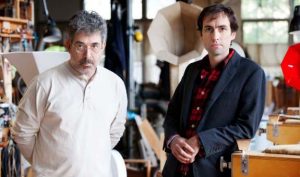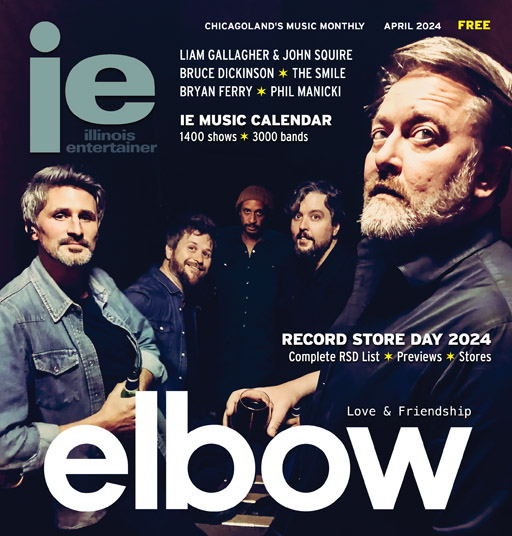Interview: Ian Schneller & Andrew Bird

Modern-art museums scare people. Maybe it’s a conservative hatred of the NEA and controversial exhibits, or a preemptive exhaustion for an afternoon to be spent doubting, That‘s art? Getting in the door is the hardest part.
Running: 12/6 to 12/30 at Museum Of Contemporary Art (220 E. Chicago Ave.) in Chicago, with special ticketed performances 12/20 and 12/21.
For the month of December, the Museum Of Contemporary Art has agreed to let a pair of gentlemen musicians use their space in a symbiotic relationship that should help newcomers in the immersion process. One, Andrew Bird, is a local treasure who doubles as a world-renowned erudite violinist/troubadour, while the other, Ian Schneller, creates internationally sought-after, handcrafted instruments and amplifiers for his own company, Specimen Products.
The two have been at this before, most notably at New York City’s Guggenheim Museum in 2010, though Bird had already been utilizing Schneller’s unique horn speakers to great effect – as when he played a winter residency at Chicago’s 4th Presbyterian Church in 2009. The MCA provided a fresh challenge for their evolving collaborations.
“In a way it was a eureka moment,” says Schneller from his Chicago office. “There used to be 4-track, then 8-track, then 16-track, and 48-track recording studios. Most of us are familiar with the notion of layering up a massive song with all those tracks and mixing them all back down to channels. But what if you didn’t mix them all back down to two channels? What if you had an extra-special system to play back all the channels that were in a specified location? So that you had an orchestral representation of a composition? That’s the basic concept. It creates an environment that, what if you went to Orchestra Hall and, during Beethoven’s 9th [Symphony], you were able to walk up on stage and mingle amongst the viola and trombone section, and then saunter over to the tympani and cello. That’s sort of what the Sonic Arboretum is, and it lends itself beautifully to the concept of installation in an art museum, because that’s what that’s all about is walking around and checking out stuff.”
To pull it off, Schneller has installed more than six- dozen horn amplifiers in the MCA’s atrium, which will perpetually broadcast singular elements of a looping Bird composition created in an empty museum.
“[Bird]’s going to workshop for a couple weeks,” Schneller told IE in October, “and then once it’s installed he’s going to come in and work after hours and build up a library of compositions that will cycle and play during museum hours for the entire month. So, in a way, Andrew’s going to be in the room as a phantom entity along with his music as it plays back and recreates this spatial and sonic phenomenon when he comes and works on the system.”
It sounds . . . ridiculously compelling and completely out there. One can’t quite picture Schneller convincing the museum’s trustees much less himself that the project was even feasible.
“That’s an interesting diplomatic thing,” he says about those conversations. “It’s a museum, and they have other shows going on and other curators working and all this stuff. We work with what they put on our platter, and we tell them what they like, and we’ve come to very amicable terms about where the architecture will be. They’ve been very generous. We’re occupying a large portion of the atrium, and there’s going to be a giant, brand-new spinning horn right in front of the revolving doors at the entrance. I love that. It should be quite a spectacle.”
As for himself, “If you want to succeed at anything in life, it takes immense endurance and conviction. And when I get ahold of a concept, there are no limits. I’ll admit that certain concepts are preposterous, but I don’t want to hear about it. The first 150 sound engineers I mentioned this concept to, the first words out of their mouths were, ‘The reason this won’t work . . .’ I’m like, ‘Fuck that!’ I guess I’m obsessed. We’re gonna take close to 80 horns to the MCA and install this system. I’m building a 24-channel single-ended triode tube amplification the good ol’ fashioned way: completely from scratch, from the ground up using all discreet components and built like a tank infrastructure, enclosures. And we’re gonna feed this thing with a digital Tascam X48 recording deck, and once this thing’s installed, Andrew Bird’s gonna show up and compose on to it specifically for this location. I believe it’s probably an unprecedented undertaking. It’s totally site-specific, destination-specific. There’s only one place in the world to absorb these compositions.”
One gets the sense Schneller didn’t need to give Bird the hard-sell.
“He’s the man for the job,” Schneller explains, “because he has a special sensitivity to building up and layering these kinds of tracks. He’s a phenom. His solo stuff, behind the looping pedals, I think he’s unparalleled at this sport. The beauty of our collaboration is he’s got his part to do, and I’ve got my part. I’m loathe to use this analogy, but one guy writes the lyrics and another writes the melodies. Obviously they have to integrate, and there is some collaboration, but basically we both have our specialties and there’s an immense amount of trust involved to let the other do their thing. I know that Andrew’s gonna show up and make beautiful music on the system, and he knows I’m going to bring a system that’s going to open up new possibilities for him compositionally.”
Schneller approaches sound, he says, from the standpoint of a repairman. And while he’s adept at restoring an aging or damaged piece, his mind flies ahead to imagine how sound in any capacity could be improved. So much so that he’s funding the Sonic Arboretum – “a labor of love” – himself. But ideas like these aren’t far-flung, random projects of a mad inventor. There’s a goal.
“I would say one of the causes I’m trying to champion here that’s an aside from my artistic revelations regarding the horns,” he says, “is bringing 1940s electronic technology into the present tense. We live in a world that’s full of disposable crap. Nobody expects to still be using the iPhone they have in their hand in two years, because they’re going to replace it with a newer model. We just take all this in stride. What I’m trying to convey and present is the notion that even in the present tense, with our hands we can make these beautifully simple, low-wattage tube amplifiers that blow away any kind of high-fidelity system that’s made today. The 2A3 electron tube is the most linear audio device ever made, and I’ll put its 3 watts up against anybody’s 200 watts of solid-state bullshit any day of the week. You’ve simply got to hear it to believe it. So that’s part of the Arboretum, is to present this ‘ancient’ technology and illustrate how it interfaces beautifully with today’s cutting-edge, digital technology. You plug an iPhone directly into this 3-watt amplifier that’s hooked up to my horns and it will blow your mind.”
Just so we can distinguish the puddles of brains from the actual art.
— Steve Forstneger










I took a guitar building class from Ian a couple years ago. This project with Bird sounds amazing.